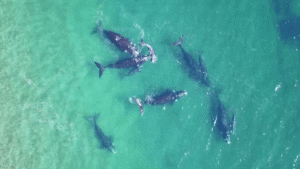Credit: Fredrik Christiansen
Editor’s Note: Special thanks to science educator Michael Windelspecht for the news tip.
Drones have improved the study and sustainability of whales by leaps and bounds over the past few years. From efforts to curb whale hunting, to researching the sea mammals’ snot (there’s a good reason for that), to helping preserve threatened species like the sperm whale.
A new research study headed by Fredrik Christiansen, a fellow with the Danish Aarhus Institute of Advanced Studies, is enhancing the drone’s reputation as a whale lover even more.
Using drone imagery, Christiansen’s team can accurately estimate the weight of whales without invasive techniques. Why is this important? In the past, only stranded or dead whales could be weighed or measured. In an article in the British Ecological Journal Methods in Ecology and Evolution, the team discovered gathering more accurate body-size data from whales will allow researchers to learn more about the physiology and ecology of whales in their natural habitat.
Christiansen explains:
“Knowing the body mass of free-living whales opens up new avenues of research. We will now be able to look at the growth of known aged individuals to calculate their body mass increase over time and the energy requirements for growth. We will also be able to look at the daily energy requirements of whales and calculate how much prey they need to consume.”
By using 3D UAV photogrammetry, the research team has been able to collaborate with the Digital Life Project at the University of Massachusetts at Amherst to recreate a 3D mesh of the whale. When completed, CG artist Robert Gutierrez recreates a full-color 3D model of the right whale.
The team capture drone-based photos of 86 whales off the coast of Península Valdés, Argentina. “The clear waters and the large number of whales that gather there every winter for breeding made it an ideal place to collect high-quality images of both the dorsal and lateral sides of the whales,” Aarhus writer Lena Bering reported. “From these they were able to obtain length, width and height measurements.”
“We used this model to estimate the body volume of whales caught in scientific whaling operations, for which body girth and mass was known,” Christiansen said.
“From these estimates of body volume and mass, we could then calculate the density of the whales, which we in turn could use to estimate the mass of free-living whales photographed by our drones.”
Jason is a longstanding contributor to DroneLife with an avid interest in all things tech. He focuses on anti-drone technologies and the public safety sector; police, fire, and search and rescue.
Beginning his career as a journalist in 1996, Jason has since written and edited thousands of engaging news articles, blog posts, press releases and online content.
Email Jason
TWITTER:@JasonPReagan
Subscribe to DroneLife here.
https://dronelife.com/2020/01/01/alls-whale-that-measures-well-drones-help-researcher-measure-marine-mammals/
 Unmanned Aerial Vehicle The latest drone news
Unmanned Aerial Vehicle The latest drone news




